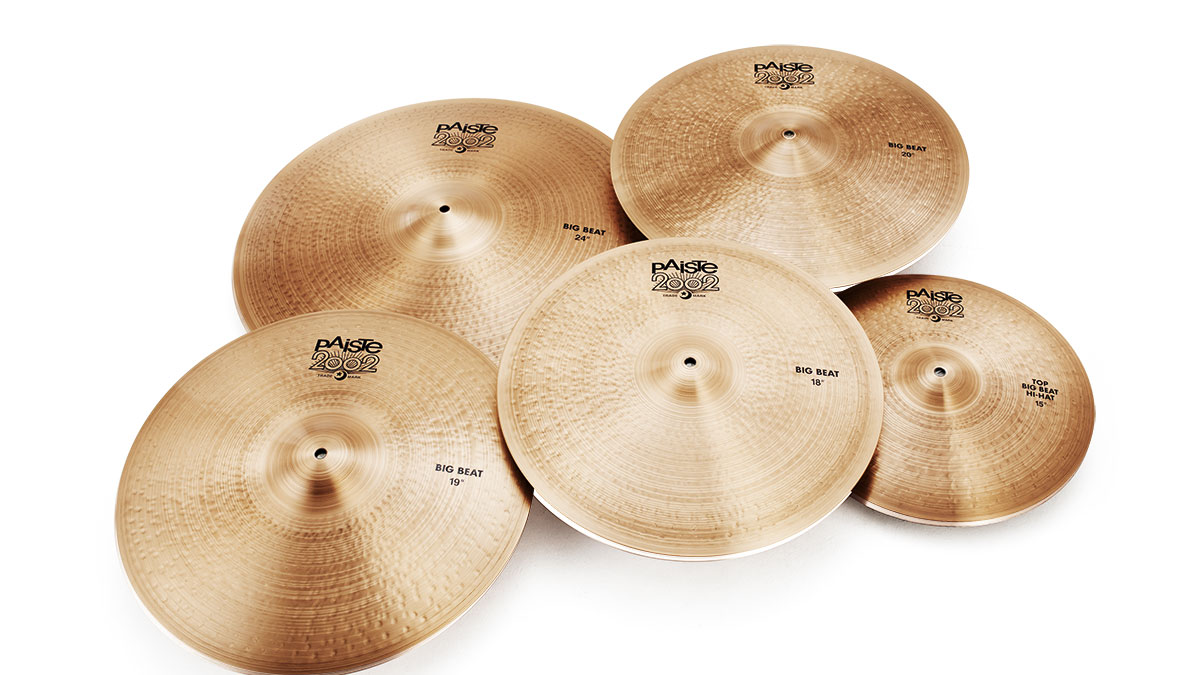MusicRadar Verdict
Paiste's 2002 B8 alloy can be sharp and bright, but the new Big Beats, while retaining the assertive clarity of expression, also have a more complex, darker and softer underbelly.
Pros
- +
Superbly well-made.
Cons
- -
Expensive.
MusicRadar's got your back

Paiste 2002 Black Big Beat Series

Paiste 2002 Black Big Beat Series
First we had Giant Beat and now we have Big Beat. What's going on?
Paiste's Giant Beats were a pioneering B8-alloy pro series played by John Bonham until they were replaced in 1971 by the 2002s. The 2002s were (are) a bit sharper, tougher and more focused.
Giant Beats were reintroduced in 2005 as a more mellow all-round version of the 2002 sound. And now we have the 2002 Black Big Beats (to give them their full handle), which are sonically related more closely to the 2002s than the Giant Beats.
Coinciding with the 45th anniversary of the original 2002 launch, the Big Beats are true to their name, with all large sizes - 18", 19", 20", 21", 22" and 24" - plus 15" and 16" hi-hats.
Build
Big Beats are made from Paiste's 2002 alloy, B8 bronze or CuSn8, with 92 percent copper and eight percent tin. This alloy has more of an orange-brown tint than B20 bronze's silvery-gold.
Then the Big Beats are slightly darkened with what Paiste calls a 'semi-matted' finish and there's a new, more striking all-over hammering pattern. Profiles are classic with not too prominent bells, while the weights are on the medium-thin side.
Hands On
Isn't it great when a cymbal takes you completely by surprise? That's what happened with this lot.
Characterised by a softness and warmth of tone we'd previously associated with B20 alloy cymbals such as Zildjian's K Keropes, we're not even sure we would have thought it possible to make B8 cymbals this temperate and buttery. We are pretty sure Paiste has never come up with anything quite like this before.
We don't have any Giant Beats to compare them with, but they are darker and warmer than the 2002s, partly because of the medium-thin weight and also the special hammering and finishing.
Paiste has never come up with anything quite like this before.
Being medium-thin and ranging from 18" to 24" the cymbals work as crashes or rides or both. Which is why Paiste has not given them descriptive names - a salutary reminder that the functional denominations cymbal companies stick on its wares are guides not strict orders!
So to get down to specifics, the 18" and 19" are the obvious crashes. Being medium-thin they are fast to engage and quite short on sustain. The 19" in particular crashes quickly and brightly and then cuts out, gated-style, rather abruptly. The 18" has more of a smooth retreat.
The soft deep character comes out immediately you start to ride them. The 20" crashes brightly, like the 19", and the stick-tip ride beat is lively and clear. But the body cushions the stick so that underneath that clean beat the spread sinks into a translucent pool of warm wash. This is best appreciated with a not too heavy or thick stick-tip. It's a cymbal you could confidently take out for a low volume acoustic piano trio and luxuriate in the fine ambience it creates.
The bigger cymbals continue in this vein with more spread, volume and breadth. The 21" really hits the sweet spot and by the 22" and the huge 24" it's credit to Paiste that they still work fine as crash-rides. There is of course an almighty whoosh if you do crash them, and what a great effect that is! But they still feel almost as happy played as big crashes as they do rides.
Overall the single cymbals are all broad with a complex wash and can give quite a bit of volume, but are not aggressive - more engagingly enveloping and supporting.
That settling character carries over to the hats. The 15s will give you that Bonham mixture of solidity with depth, that sizzle and unhurried shuffle.
We've not played 16" hats before but were surprised just how manageable they were. Pocket players like Steve Jordan and Herman Matthews sometimes prefer large diameter hats.
We recall seeing Herman Matthews playing 18" hats with Tom Jones. He explained to Rhythm, "They're a little darker so they get out of the way of the vocalist." All the Big Beats had that unhurried, uncluttered, calming vibe.
And this made me think that if you landed the live gig with Sir Tom, encompassing 50 years of hugely varied music styles, then the Big Beats would not be a bad choice of platters.
“Even my cat is disappointed in me”: Deadmau5 gets drunk at Coachella, falls over, is escorted off stage by security, and apologises
“The last thing Billy and I wanted to do was retread and say, ‘Hey, let’s do another Rebel Yell.’ We’ve already done that”: Guitar hero Steve Stevens lifts the lid on the new Billy Idol album
"This $399 item will incur over $578 in additional import charges": Price of Sonicware CyDrums drum machine more than doubles thanks to Trump tariffs









